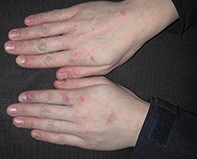Peer Reviewed
Feature Article Occupational health
Hand dermatitis
Abstract
Hand dermatitis is a common occupational problem that often causes considerable stress and disability. This article describes the management of irritant and atopic hand dermatitis plus secondary protein contact dermatitis in a young woman.
Key Points
- Hand dermatitis is the most common occupational skin disease and up to 30% of all occupational diseases are dermatological.
- Hand dermatitis can be categorised into exogenous and endogenous forms. Endogenous forms include atopic dermatitis, pompholyx (dyshidrotic eczema) and hyperkeratotic (psoriasiform) hand dermatitis. Exogenous forms include irritant contact dermatitis, allergic contact dermatitis, protein contact dermatitis, frictional dermatitis and photoallergic or phototoxic dermatitis.
- Management of hand dermatitis includes identifying and eliminating the causes, protecting the skin where practical, improving the skin’s barrier function, and treating the inflammation of the dermatitis. This can be achieved by allergen avoidance, use of barrier creams, gloves and moisturisers, use of topical corticosteroids and other agents, and phototherapy.
- A case study approach is used in this article to illustrate the multiple aetiologies and the management of hand dermatitis.
Purchase the PDF version of this article
Already a subscriber? Login here.

